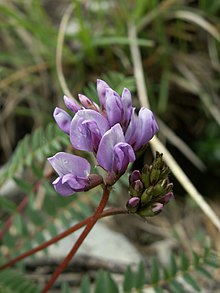Oxytropis
Today, Oxytropis is a topic that has gained relevance in different areas of society. Its influence extends from the personal to the business sphere, including politics and culture. Over the years, Oxytropis has aroused growing interest, generating significant debates, research and transformations. In this article, we will explore in detail the impact of Oxytropis, analyzing its different dimensions and reflecting on its importance today. From its origins to its contemporary evolution, Oxytropis continues to be a topic of relevant discussion and of great interest to the general public.
This article includes a list of general references, but it lacks sufficient corresponding inline citations. (July 2020) |
| Oxytropis | |
|---|---|

| |
| Oxytropis jacquinii | |
| Scientific classification | |
| Kingdom: | Plantae |
| Clade: | Tracheophytes |
| Clade: | Angiosperms |
| Clade: | Eudicots |
| Clade: | Rosids |
| Order: | Fabales |
| Family: | Fabaceae |
| Subfamily: | Faboideae |
| Clade: | Inverted repeat-lacking clade |
| Tribe: | Galegeae |
| Subtribe: | Astragalinae |
| Genus: | Oxytropis DC. (1802) |
| Synonyms | |
| |
Oxytropis is a genus of plants in the legume family. It includes over 600 species native to subarctic to temperate regions of North America and Eurasia. It is one of three genera of plants known as locoweeds, and are notorious for being toxic to grazing animals. The other locoweed genus is the closely related Astragalus. Most oxtropis species are native to Eurasia and North America, but several species are native to the Arctic. These are hairy perennial plants which produce raceme inflorescences of pink, purple, white, or yellow flowers which are generally pea-like but have distinctive sharply beaked keels. The stems are leafless, the leaves being all basal. The plant produces legume pods containing the seeds.
Selected species
- Oxytropis arctica – Arctic locoweed
- Oxytropis bellii
- Oxytropis borealis – boreal locoweed
- Oxytropis campestris – field locoweed
- Oxytropis deflexa – nodding locoweed
- Oxytropis halleri – purple oxytropis
- Oxytropis jacquinii
- Oxytropis kobukensis – Kobuk locoweed
- Oxytropis lambertii – purple locoweed
- Oxytropis monticola – yellow-flowered locoweed
- Oxytropis nitens
- Oxytropis ocrensis
- Oxytropis oreophila – mountain oxytrope
- Oxytropis oxyphylla
- Oxytropis parryi – Parry's locoweed
- Oxytropis pilosa
- Oxytropis podocarpa – stalkpod locoweed
- Oxytropis prenja
- Oxytropis prostrata
- Oxytropis pseudoglandulosa
- Oxytropis riparia – Oxus locoweed
- Oxytropis sericea – white locoweed
- Oxytropis sordida
- Oxytropis strobilacea
- Oxytropis todomoshiriensis
References
- ^ a b Oxytropis DC. Plants of the World Online. Retrieved 12 September 2023.
- ^ Taylor, Ronald J. (1994) . Sagebrush Country: A Wildflower Sanctuary (rev. ed.). Missoula, MT: Mountain Press Pub. Co. p. 102. ISBN 0-87842-280-3. OCLC 25708726.
External links
 Media related to Oxytropis at Wikimedia Commons
Media related to Oxytropis at Wikimedia Commons- Jepson Manual Treatment
- USDA Plants Profile